Xinhang Xu
Energy-Constrained Navigation for Planetary Rovers under Hybrid RTG-Solar Power
Sep 18, 2025Abstract:Future planetary exploration rovers must operate for extended durations on hybrid power inputs that combine steady radioisotope thermoelectric generator (RTG) output with variable solar photovoltaic (PV) availability. While energy-aware planning has been studied for aerial and underwater robots under battery limits, few works for ground rovers explicitly model power flow or enforce instantaneous power constraints. Classical terrain-aware planners emphasize slope or traversability, and trajectory optimization methods typically focus on geometric smoothness and dynamic feasibility, neglecting energy feasibility. We present an energy-constrained trajectory planning framework that explicitly integrates physics-based models of translational, rotational, and resistive power with baseline subsystem loads, under hybrid RTG-solar input. By incorporating both cumulative energy budgets and instantaneous power constraints into SE(2)-based polynomial trajectory optimization, the method ensures trajectories that are simultaneously smooth, dynamically feasible, and power-compliant. Simulation results on lunar-like terrain show that our planner generates trajectories with peak power within 0.55 percent of the prescribed limit, while existing methods exceed limits by over 17 percent. This demonstrates a principled and practical approach to energy-aware autonomy for long-duration planetary missions.
AEOS: Active Environment-aware Optimal Scanning Control for UAV LiDAR-Inertial Odometry in Complex Scenes
Sep 11, 2025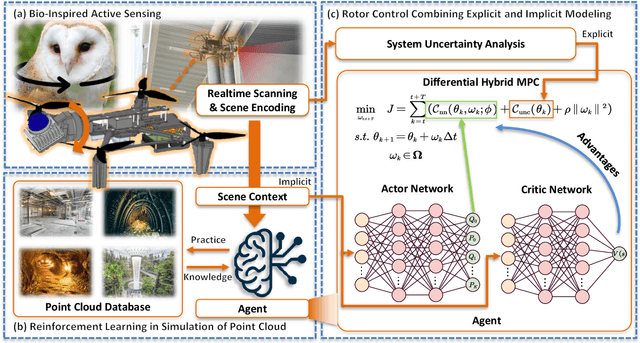

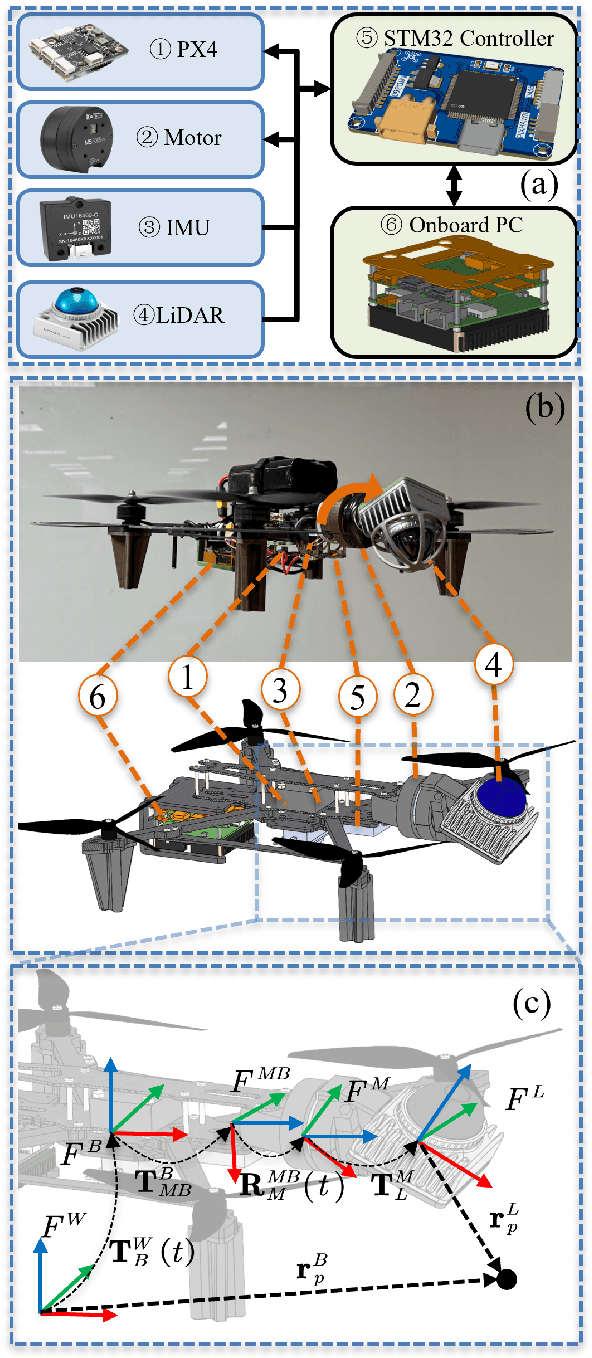

Abstract:LiDAR-based 3D perception and localization on unmanned aerial vehicles (UAVs) are fundamentally limited by the narrow field of view (FoV) of compact LiDAR sensors and the payload constraints that preclude multi-sensor configurations. Traditional motorized scanning systems with fixed-speed rotations lack scene awareness and task-level adaptability, leading to degraded odometry and mapping performance in complex, occluded environments. Inspired by the active sensing behavior of owls, we propose AEOS (Active Environment-aware Optimal Scanning), a biologically inspired and computationally efficient framework for adaptive LiDAR control in UAV-based LiDAR-Inertial Odometry (LIO). AEOS combines model predictive control (MPC) and reinforcement learning (RL) in a hybrid architecture: an analytical uncertainty model predicts future pose observability for exploitation, while a lightweight neural network learns an implicit cost map from panoramic depth representations to guide exploration. To support scalable training and generalization, we develop a point cloud-based simulation environment with real-world LiDAR maps across diverse scenes, enabling sim-to-real transfer. Extensive experiments in both simulation and real-world environments demonstrate that AEOS significantly improves odometry accuracy compared to fixed-rate, optimization-only, and fully learned baselines, while maintaining real-time performance under onboard computational constraints. The project page can be found at https://kafeiyin00.github.io/AEOS/.
Tire Wear Aware Trajectory Tracking Control for Multi-axle Swerve-drive Autonomous Mobile Robots
Jun 05, 2025Abstract:Multi-axle Swerve-drive Autonomous Mobile Robots (MS-AGVs) equipped with independently steerable wheels are commonly used for high-payload transportation. In this work, we present a novel model predictive control (MPC) method for MS-AGV trajectory tracking that takes tire wear minimization consideration in the objective function. To speed up the problem-solving process, we propose a hierarchical controller design and simplify the dynamic model by integrating the \textit{magic formula tire model} and \textit{simplified tire wear model}. In the experiment, the proposed method can be solved by simulated annealing in real-time on a normal personal computer and by incorporating tire wear into the objective function, tire wear is reduced by 19.19\% while maintaining the tracking accuracy in curve-tracking experiments. In the more challenging scene: the desired trajectory is offset by 60 degrees from the vehicle's heading, the reduction in tire wear increased to 65.20\% compared to the kinematic model without considering the tire wear optimization.
Unsupervised Anomaly Detection for Autonomous Robots via Mahalanobis SVDD with Audio-IMU Fusion
May 09, 2025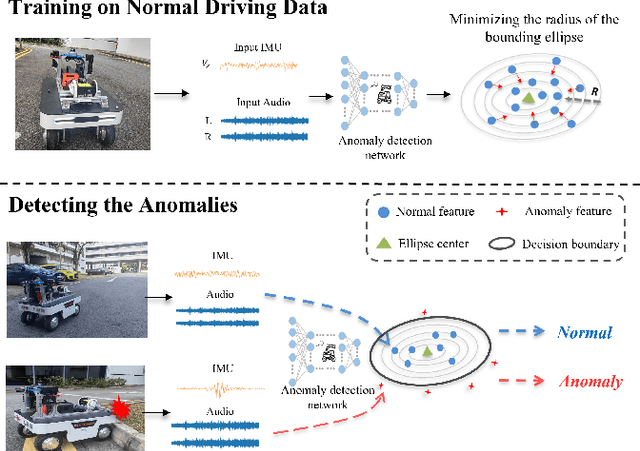
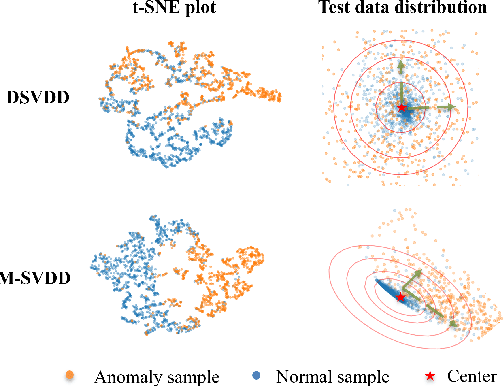
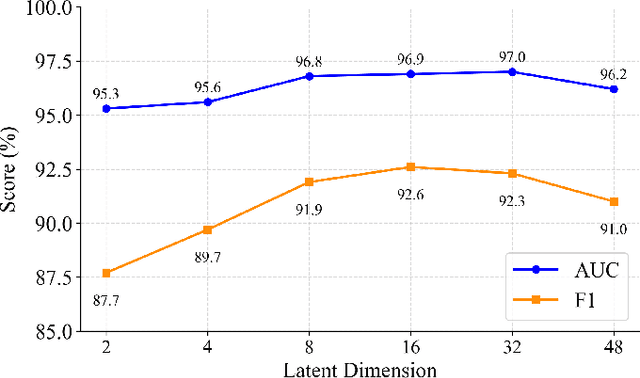
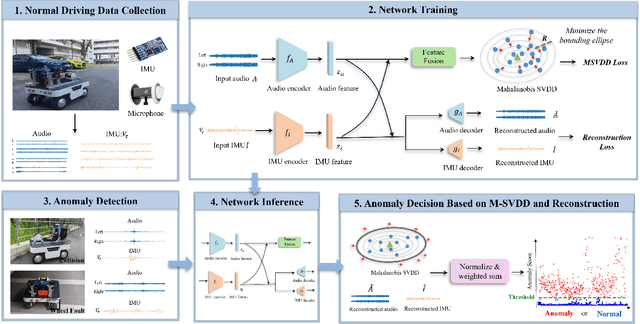
Abstract:Reliable anomaly detection is essential for ensuring the safety of autonomous robots, particularly when conventional detection systems based on vision or LiDAR become unreliable in adverse or unpredictable conditions. In such scenarios, alternative sensing modalities are needed to provide timely and robust feedback. To this end, we explore the use of audio and inertial measurement unit (IMU) sensors to detect underlying anomalies in autonomous mobile robots, such as collisions and internal mechanical faults. Furthermore, to address the challenge of limited labeled anomaly data, we propose an unsupervised anomaly detection framework based on Mahalanobis Support Vector Data Description (M-SVDD). In contrast to conventional SVDD methods that rely on Euclidean distance and assume isotropic feature distributions, our approach employs the Mahalanobis distance to adaptively scale feature dimensions and capture inter-feature correlations, enabling more expressive decision boundaries. In addition, a reconstruction-based auxiliary branch is introduced to preserve feature diversity and prevent representation collapse, further enhancing the robustness of anomaly detection. Extensive experiments on a collected mobile robot dataset and four public datasets demonstrate the effectiveness of the proposed method, as shown in the video https://youtu.be/yh1tn6DDD4A. Code and dataset are available at https://github.com/jamesyang7/M-SVDD.
Following Is All You Need: Robot Crowd Navigation Using People As Planners
Apr 15, 2025Abstract:Navigating in crowded environments requires the robot to be equipped with high-level reasoning and planning techniques. Existing works focus on developing complex and heavyweight planners while ignoring the role of human intelligence. Since humans are highly capable agents who are also widely available in a crowd navigation setting, we propose an alternative scheme where the robot utilises people as planners to benefit from their effective planning decisions and social behaviours. Through a set of rule-based evaluations, we identify suitable human leaders who exhibit the potential to guide the robot towards its goal. Using a simple base planner, the robot follows the selected leader through shorthorizon subgoals that are designed to be straightforward to achieve. We demonstrate through both simulated and real-world experiments that our novel framework generates safe and efficient robot plans compared to existing planners, even without predictive or data-driven modules. Our method also brings human-like robot behaviours without explicitly defining traffic rules and social norms. Code will be available at https://github.com/centiLinda/PeopleAsPlanner.git.
Handle Object Navigation as Weighted Traveling Repairman Problem
Mar 10, 2025Abstract:Zero-Shot Object Navigation (ZSON) requires agents to navigate to objects specified via open-ended natural language without predefined categories or prior environmental knowledge. While recent methods leverage foundation models or multi-modal maps, they often rely on 2D representations and greedy strategies or require additional training or modules with high computation load, limiting performance in complex environments and real applications. We propose WTRP-Searcher, a novel framework that formulates ZSON as a Weighted Traveling Repairman Problem (WTRP), minimizing the weighted waiting time of viewpoints. Using a Vision-Language Model (VLM), we score viewpoints based on object-description similarity, projected onto a 2D map with depth information. An open-vocabulary detector identifies targets, dynamically updating goals, while a 3D embedding feature map enhances spatial awareness and environmental recall. WTRP-Searcher outperforms existing methods, offering efficient global planning and improved performance in complex ZSON tasks. Code and more demos will be avaliable on https://github.com/lrm20011/WTRP_Searcher.
LiMo-Calib: On-Site Fast LiDAR-Motor Calibration for Quadruped Robot-Based Panoramic 3D Sensing System
Feb 18, 2025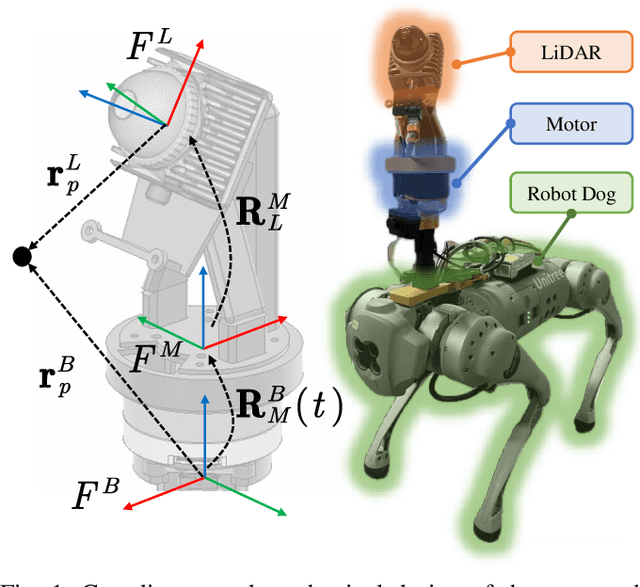
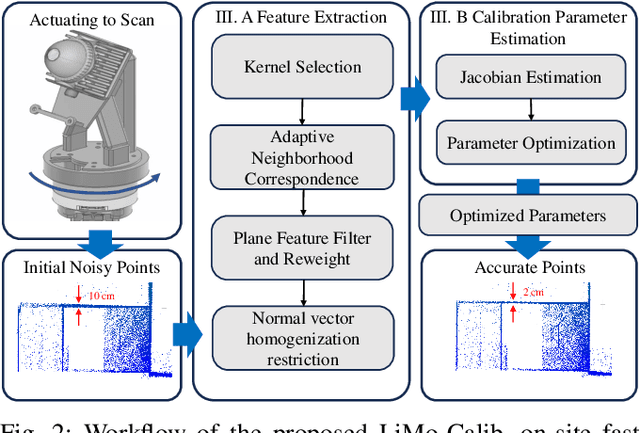
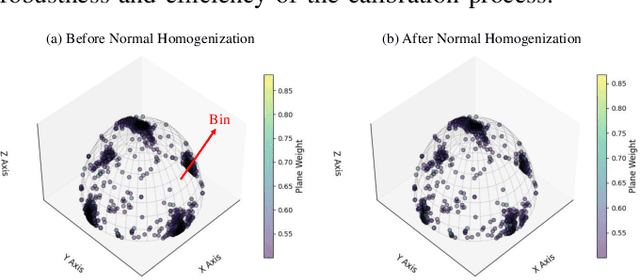

Abstract:Conventional single LiDAR systems are inherently constrained by their limited field of view (FoV), leading to blind spots and incomplete environmental awareness, particularly on robotic platforms with strict payload limitations. Integrating a motorized LiDAR offers a practical solution by significantly expanding the sensor's FoV and enabling adaptive panoramic 3D sensing. However, the high-frequency vibrations of the quadruped robot introduce calibration challenges, causing variations in the LiDAR-motor transformation that degrade sensing accuracy. Existing calibration methods that use artificial targets or dense feature extraction lack feasibility for on-site applications and real-time implementation. To overcome these limitations, we propose LiMo-Calib, an efficient on-site calibration method that eliminates the need for external targets by leveraging geometric features directly from raw LiDAR scans. LiMo-Calib optimizes feature selection based on normal distribution to accelerate convergence while maintaining accuracy and incorporates a reweighting mechanism that evaluates local plane fitting quality to enhance robustness. We integrate and validate the proposed method on a motorized LiDAR system mounted on a quadruped robot, demonstrating significant improvements in calibration efficiency and 3D sensing accuracy, making LiMo-Calib well-suited for real-world robotic applications. The demo video is available at: https://youtu.be/FMINa-sap7g
AToM: Adaptive Theory-of-Mind-Based Human Motion Prediction in Long-Term Human-Robot Interactions
Feb 09, 2025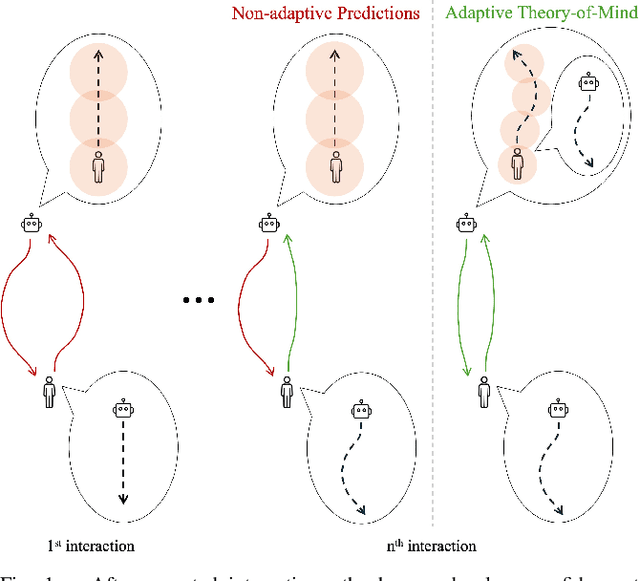
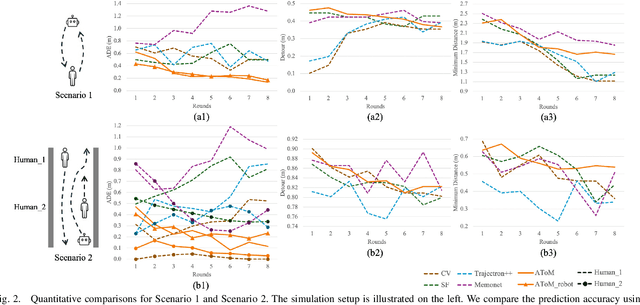
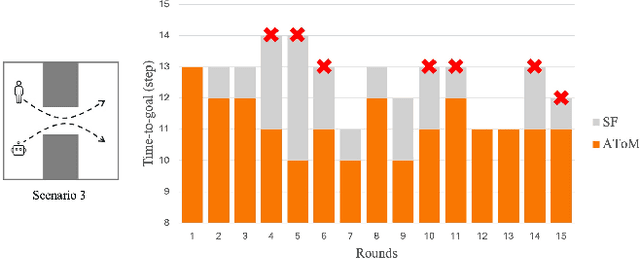
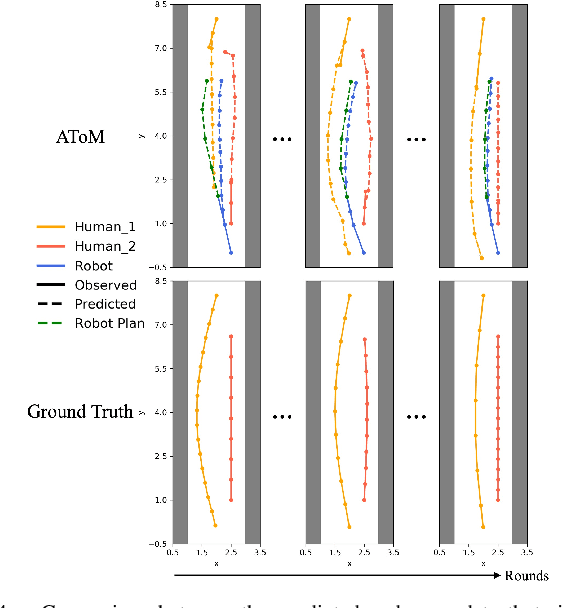
Abstract:Humans learn from observations and experiences to adjust their behaviours towards better performance. Interacting with such dynamic humans is challenging, as the robot needs to predict the humans accurately for safe and efficient operations. Long-term interactions with dynamic humans have not been extensively studied by prior works. We propose an adaptive human prediction model based on the Theory-of-Mind (ToM), a fundamental social-cognitive ability that enables humans to infer others' behaviours and intentions. We formulate the human internal belief about others using a game-theoretic model, which predicts the future motions of all agents in a navigation scenario. To estimate an evolving belief, we use an Unscented Kalman Filter to update the behavioural parameters in the human internal model. Our formulation provides unique interpretability to dynamic human behaviours by inferring how the human predicts the robot. We demonstrate through long-term experiments in both simulations and real-world settings that our prediction effectively promotes safety and efficiency in downstream robot planning. Code will be available at https://github.com/centiLinda/AToM-human-prediction.git.
Cooperative Aerial Robot Inspection Challenge: A Benchmark for Heterogeneous Multi-UAV Planning and Lessons Learned
Jan 14, 2025



Abstract:We propose the Cooperative Aerial Robot Inspection Challenge (CARIC), a simulation-based benchmark for motion planning algorithms in heterogeneous multi-UAV systems. CARIC features UAV teams with complementary sensors, realistic constraints, and evaluation metrics prioritizing inspection quality and efficiency. It offers a ready-to-use perception-control software stack and diverse scenarios to support the development and evaluation of task allocation and motion planning algorithms. Competitions using CARIC were held at IEEE CDC 2023 and the IROS 2024 Workshop on Multi-Robot Perception and Navigation, attracting innovative solutions from research teams worldwide. This paper examines the top three teams from CDC 2023, analyzing their exploration, inspection, and task allocation strategies while drawing insights into their performance across scenarios. The results highlight the task's complexity and suggest promising directions for future research in cooperative multi-UAV systems.
UA-MPC: Uncertainty-Aware Model Predictive Control for Motorized LiDAR Odometry
Dec 18, 2024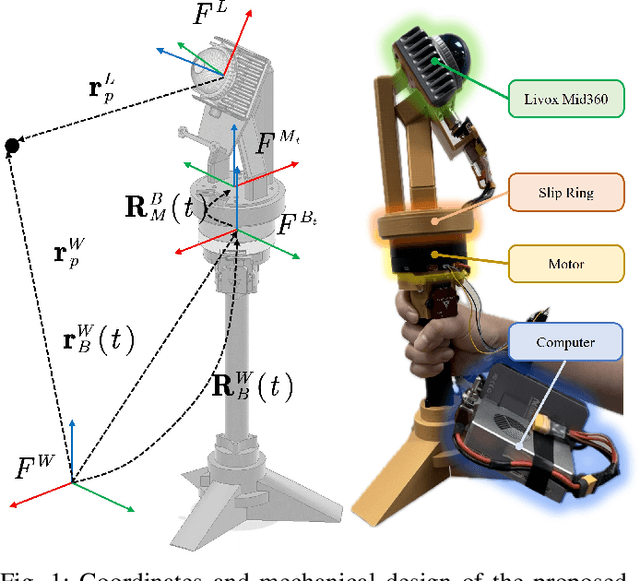


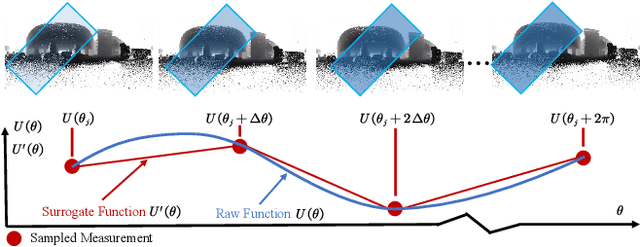
Abstract:Accurate and comprehensive 3D sensing using LiDAR systems is crucial for various applications in photogrammetry and robotics, including facility inspection, Building Information Modeling (BIM), and robot navigation. Motorized LiDAR systems can expand the Field of View (FoV) without adding multiple scanners, but existing motorized LiDAR systems often rely on constant-speed motor control, leading to suboptimal performance in complex environments. To address this, we propose UA-MPC, an uncertainty-aware motor control strategy that balances scanning accuracy and efficiency. By predicting discrete observabilities of LiDAR Odometry (LO) through ray tracing and modeling their distribution with a surrogate function, UA-MPC efficiently optimizes motor speed control according to different scenes. Additionally, we develop a ROS-based realistic simulation environment for motorized LiDAR systems, enabling the evaluation of control strategies across diverse scenarios. Extensive experiments, conducted on both simulated and real-world scenarios, demonstrate that our method significantly improves odometry accuracy while preserving the scanning efficiency of motorized LiDAR systems. Specifically, it achieves over a 60\% reduction in positioning error with less than a 2\% decrease in efficiency compared to constant-speed control, offering a smarter and more effective solution for active 3D sensing tasks. The simulation environment for control motorized LiDAR is open-sourced at: \url{https://github.com/kafeiyin00/UA-MPC.git}.
 Add to Chrome
Add to Chrome Add to Firefox
Add to Firefox Add to Edge
Add to Edge